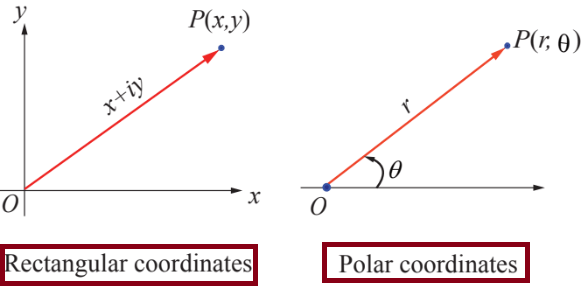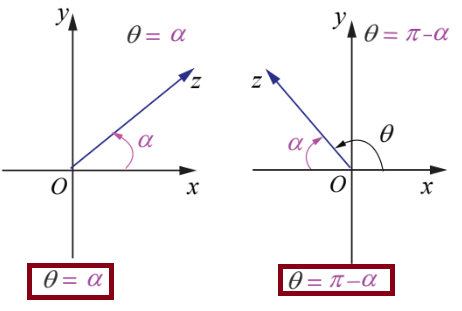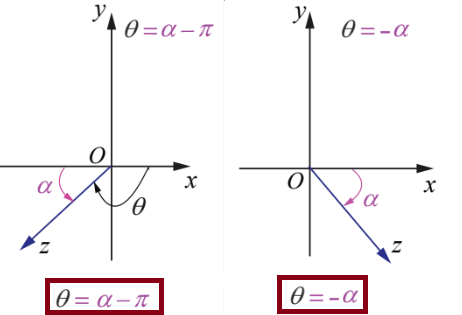CONVERTING RECTANGULAR FORM TO POLAR FORM
Let r and θ be polar coordinates of the point P(x, y) that corresponds to a non zero complex number z = x + iy.
The real number θ represents the angle, measured in radians, that z makes with the positive real axis when z is interpreted as a radius vector.

The angle θ has an infinitely many possible values, including negative ones that differ by integral multiples of 2π.
Those values can be determined from the equation
tan θ = y/x.
- The required angle lies in the 1st quadrant, then θ = α
- The required angle lies in the 2nd quadrant, then
θ = π-α
- The required angle lies in the 3rd quadrant, then
θ = -π+α
- The required angle lies in the 4th quadrant, then
θ = -α


Find the polar coordinates of the point with the given rectangular coordinates
Problem 1 :
(-5, 12)
Solution :
Rectangular form (x, y) ==> (-5, 12)
Polar form (r, θ) ==> ?
Finding r :
r = √(x2 + y2)
r = √(-5)2 + 122
r = √(25 + 144)
r = √169
r = 13
Finding θ :
θ = tan-1(y/x)
x = -5 and y = 12
θ lies in the 2nd quadrant
θ = π - α
α = tan-1(12/5)
θ = π - tan-1(12/5)
θ = 180 - 67.38
θ = 112.62
So, the required polar coordinate is ( 13, 112.62 ).
Problem 2 :
(3, -3)
Solution :
Rectangular form (x, y) ==> (-3, 3)
Polar form (r, θ) ==> ?
Finding r :
r = √(x2 + y2)
r = √32 + (-3)2
r = √(9+9)
r = √18
r = 3√2
Finding θ :
α = tan-1(y/x)
x = 3 and y = -3
θ lies in the 4th quadrant.
θ = -α
θ = -tan-1(3/3)
θ = -tan-1(1)
θ = -π/4
So, the required polar coordinate is (3√2, -π/4).
Problem 3 :
(-2, -2√3)
Solution :
Rectangular form (x, y) ==> (-2, -2√3)
Polar form (r, θ) ==> ?
Finding r :
r = √(x2 + y2)
r = √(-2)2 + (-2√3)2
r = √(4+12)
r = √16
r = 4
Finding θ :
θ = tan-1(y/x)
x = -2 and y = -2√3
θ lies in 3rd quadrant.
α = tan-1(2√3/2)
α = tan-1(√3)
α = π/3
θ = (π/3) - π
θ = (-2π/3)
So, the required polar coordinate is (4, (-2π/3)).
Problem 4 :
(0, -3)
Solution :
Rectangular form (x, y) ==> (0, -3)
Polar form (r, θ) ==> ?
Finding r :
r = √(x2 + y2)
r = √02 + (-3)2
r = √9
r = 3
Finding θ :
θ = tan-1(y/x)
x = 0 and y = -3
α = tan-1(0/3
α = tan-1(0)
α = 0
θ = 0 - π
θ = -π
So, the required polar coordinate is (3, -π).
Problem 5 :
(5, 5)
Solution :
Rectangular form (x, y) ==> (5, 5)
Polar form (r, θ) ==> ?
Finding r :
r = √(x2 + y2)
r = √52 + 52
r = 5√2
Finding θ :
θ = tan-1(y/x)
x = 5 and y = 5
θ lies in the first quadrant.
α = tan-1(5/5)
α = tan-1(1)
α = π/4
θ = π/4
So, the required polar coordinate is (5√2, π/4).
Problem 6 :
(-1, √3)
Solution :
Rectangular form (x, y) ==> (-1, √3)
Polar form (r, θ) ==> ?
Finding r :
r = √(x2 + y2)
r = √(-1)2 + (√3)2
r = √(1 + 3)
r = 2
Finding θ :
θ = tan-1(y/x)
x = -1 and y = √3
θ lies in the second quadrant.
α = tan-1(√3/1)
α = tan-1(√3)
α = π/3
θ = π - (π/3)
θ = 2π/3
So, the required polar coordinate is (2, 2π/3).
Recent Articles
-
Finding Range of Values Inequality Problems
May 21, 24 08:51 PM
Finding Range of Values Inequality Problems -
Solving Two Step Inequality Word Problems
May 21, 24 08:51 AM
Solving Two Step Inequality Word Problems -
Exponential Function Context and Data Modeling
May 20, 24 10:45 PM
Exponential Function Context and Data Modeling